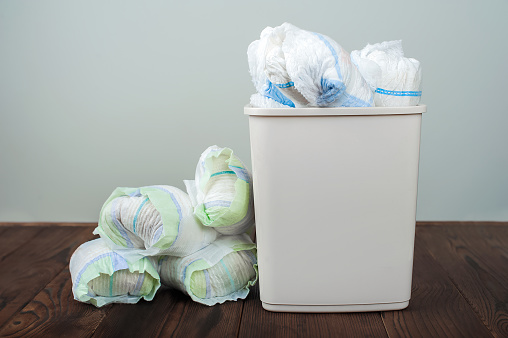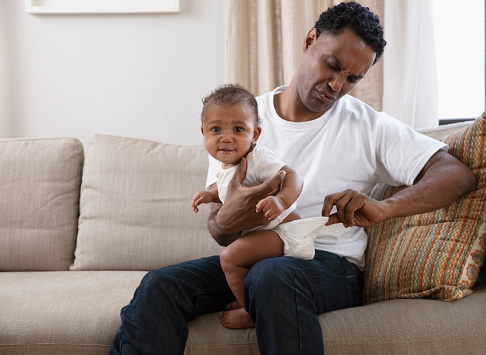
Did anyone ever tell you the great variety of poop What can be found in the baby's diaper?
Liquid or hard, black, green or yellow, baby poop may have many tones and textures different.
Those diaper changes are an important part of any parent's daily routine, but they can also be a way to monitor health of the baby.
Today we will learn to differentiate what color, consistency and frequency of baby poop can tell us about the health and development of the little one.
Baby poop: what is normal?
Maybe you have ever wondered what a healthy baby's poop should look like. It is normal for you to wonder because the color and consistency of your baby's stool change over time depending on various factors, especially what he eats.
I leave you a guide of what you can find in the diapers of the little ones during the first days, weeks and months after birth.
Meconium
Your baby's first diapers will likely contain a sticky, dark green substance, similar to tar, and with hardly any odor. This is called meconium.
This special type of stool is made of things like skin cells, mucus, hairs, and other particles that the little one swallowed along with amniotic fluid while still in the womb.
It takes a few days to remove all the meconium from your system, but then you will start to have regular bowel movements. At this point, your poop will go from almost black to a shade yellowish green.
Let your pediatrician know if the first bowel movement does not occur within the first 24 hours after birth!.
Baby poop according to how we feed it
Once the meconium is out of the baby's system, the little one's poop can vary a lot depending on how we feed it. This is what we would probably find in diapers in different cases:
-
Breastfed babies If we breastfeed the baby, his stools in the first months may look a bit like the mustard from Dijon, with a consistency slightly runny and possibly with off-white fat particles that look like seeds. The color of your baby's stool can also change depending on what he is eating. For example, if you eat green vegetables like spinach, they may have a green hue.
-
Formula fed babies. In this case your poop will not be as liquid as that of a breastfed baby. It will have a consistency more pasty (although it shouldn't be firmer than peanut butter) and a color darker yellow or roasted.
-
Babies in weaning stage. When we start to introduce food solid, which is recommended after 6 months, we will see (and smell!) some important changes in the content of the diapers. Your feces will become firmer and its color will also vary. We may see pieces of food undigested, such as pea skins or tomatoes. This is because your little one's digestive system is still learning to process all of these new foods. The weaning period is also when the poop will start to smell stronger, due to the extra fats and sugars in the diet.
Green, Gray, Red - What Can Baby Poop Colors Mean?
La green poopIn particular, it can be alarming the first time we see it, but it is usually harmless. It can be caused by various reasons, from certain drugs (taken by the baby himself or even by us if we are breastfeeding the little one) until green foods that the baby ingests directly or is transmitted through breast milk.
As a general rule, all earth tones (yellow, green and brown) are fine, but if you ever need to make sure, don't hesitate to ask your pediatrician for advice.
Warning colors
There are certain colors of stool that can be a sign of a possible health problem:
-
Red. Traces of red may be due to Blood in the stool. In a newborn baby, some blood may have been swallowed during delivery. If we breastfeed, the nipples may bleed a little and the blood may mix with the breast milk. If the little one already eats solids, it may be because of the color of some type of food, such as beets, which can color the poop. Anyway, you have to go to the pediatrician to determine what it is.
-
Black. In some cases, black stools may be caused by blood, which can change from red to black within the intestines over time. It is important to know that very dark green stools can sometimes appear black. Green baby poop, even with a dark shade of the color, is generally nothing to worry about. Meconium can also look black and this is not a problem.
-
White or gray. Very pale white or clay-colored stools are very rare, but if we see poop of this color on the diaper, we must call the pediatricianas it could be a sign of a liver condition that needs treatment.
How often should a baby poop?
La frequency How a baby poops will change as his digestive system grows and develops, but it will also be affected by the feeding method he uses.
If we breastfeed
He is likely to defecate more frequently than if we fed him formula. As a general rule of thumb, after the first few days, you may 2 to 5 bowel movements a day, until he is around 6 weeks old.
After 3 to 6 weeks of age, if we breastfeed they can spend several days between bowel movements. This is because the baby's digestive system can process breast milk very efficiently, leaving very little solid waste.
After 6 weeks, you can poop less than before. One of the reasons for this is that at that time the breast milk usually no longer contains colostrum, which can act as a laxative.
If you drink formula
Whether we give him all the formula milk or just part of it, after the first few days he can start filling his diaper at least once a day. Although it is usual for a day or two to go by without defecating. This is fine, as long as your stools are soft.
When can we say that the baby is pooping too much?
The amount of poo you do each time can vary. As long as your weight gain is on track and the stools are soft, things are probably fine.
If the little boy's poop seems wateryespecially if he poops much more often than usual, or if you have other symptoms, such as high fever it's about diarrhea. You have to go to the doctor as soon as possible.
Newborns and younger babies are more likely to have poop smaller and more times. If the baby has just had a bowel movement, we may be able to save an extra diaper change by waiting a little longer ...
When can we say that I have constipation?
Constipation is more common after the introduction of solids, but it can also occur in younger babies. Here are some typical signs of constipation:
-
In a newborn baby. Hard stools and less than once a day.
-
In an older baby or young child. Hard and compact stools than every three or four days.
-
In a baby or child of any age. Large, hard, dry stools that are painful when you have a bowel movement. If there is blood in the stool or if the child strains for more than 10 minutes without defecating.
What can be done about constipation?
First of all, the pediatrician or pharmacist should be consulted. We should not give any medicine, or a laxative, unless our health professionals communicate it.
If it does not improve or you have other symptoms such as vomiting, fever, lethargy, loss of appetite or blood in the stool, you have to go to the doctor as soon as possible.
How can we tell if the baby has already pooped?
It is possible that the poop doesn't smell muchespecially in the first few weeks, so how do we know when he's ready for a diaper change?
A telltale sign is the effort- Passing stool is hard work for young babies. They usually turn red with the effort of getting that poop out. Soon you will be able to distinguish the facial expression of your own baby when he defecates. It is a matter of observing it.
If we are not sure if there is something there, we just have to take a look at the diaper without taking it off. To do this, we gently pull the waist at the back and take a look inside.




